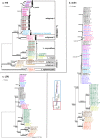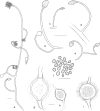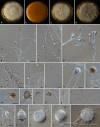Species recognition and clinical relevance of the zygomycetous genus Lichtheimia (syn. Absidia pro parte, Mycocladus)
- PMID: 20357218
- PMCID: PMC2884488
- DOI: 10.1128/JCM.01744-09
Species recognition and clinical relevance of the zygomycetous genus Lichtheimia (syn. Absidia pro parte, Mycocladus)
Abstract
The zygomycete genus Lichtheimia (syn. Absidia pro parte, Mycocladus) consists of saprotrophic fungi inhabiting soil or dead plant material. Lichtheimia corymbifera (syn. Absidia corymbifera, Mycocladus corymbifer) and Lichtheimia ramosa (syn. Absidia ramosa, Mycocladus ramosus) may cause fulminant infections in patients with impaired immunity. The present study investigated the species boundaries in Lichtheimia using genealogical concordance phylogenetic species recognition (by comparison of the genealogies of the internal transcribed spacer [ITS] sequence, the D1/D2 region of the large subunit [LSU], and actin), biological species recognition by mating tests, as well as morphological and physiological characteristics. The three molecular markers used were selected by evaluating the polymorphisms and paralogies of several loci, including those for beta-tubulin, translation elongation factor 1alpha, the two largest subunits of the RNA polymerase II (RPB1 and RPB2), the mitochondrial cytochrome c oxidase subunit I (COI), and the mitochondrial small-subunit (mtSSU) rDNA, among four strains belonging to different putative species. Comparing the genealogies of the ITS, LSU, and actin genes, we recognized seven phylogenetic species. However, mating tests did not show intrinsic reproductive barriers for two pairs of the phylogenetic species. Therefore, we regard five species in Lichtheima to be confirmed: Lichtheimia corymbifera, L. ornata comb. nov., L. ramosa, L. hyalospora, and L. sphaerocystis sp. nov. Only the first three species seem to have clinical relevance. Lichtheimia blakesleeana is reduced to a synonym of Lichtheimia hyalospora. We provide a detailed description of Lichtheimia sphaerocystis sp. nov. and a key for the identification of all accepted species identified in the present study on the basis of their morphological traits and growth at different temperatures.
Figures









References
-
- Chen, G.-Q., and R.-Y. Zheng. 1998. A new thermophilic variety of Absidia idahoensis from China. Mycotaxon 69:173-179.
-
- de Hoog, G. S., and A. H. G. Gerrits van den Ende. 1998. Molecular diagnostics of clinical strains of filamentous basidiomycetes. Mycoses 41:183-189. - PubMed
-
- Dettman, J. R., D. J. Jacobson, and J. W. Taylor. 2003. A multilocus genealogical approach to phylogenetic species recognition in the model eukaryote Neurospora. Evolution 57:2703-2720. - PubMed
-
- Ellis, J. J., and G. W. Hesseltine. 1966. Species of Absidia with ovoid sporangiospores. II. Sabouraudia 5:59-77. - PubMed
-
- Fidel, S., J. H. Doonan, and N. R. Morris. 1988. Aspergillus nidulans contains a single actin gene which has unique intron locations and encodes a γ-actin. Gene 70:283-293. - PubMed
MeSH terms
Substances
Associated data
- Actions
- Actions
- Actions
- Actions
- Actions
- Actions
- Actions
- Actions
- Actions
- Actions
- Actions
- Actions
- Actions
- Actions
- Actions
- Actions
- Actions
- Actions
- Actions
- Actions
- Actions
- Actions
- Actions
- Actions
- Actions
- Actions
- Actions
- Actions
- Actions
- Actions
- Actions
- Actions
- Actions
- Actions
- Actions
- Actions
- Actions
- Actions
- Actions
- Actions
- Actions
- Actions
- Actions
- Actions
- Actions
- Actions
- Actions
- Actions
- Actions
- Actions
- Actions
- Actions
- Actions
- Actions
- Actions
- Actions
- Actions
- Actions
- Actions
- Actions
- Actions
- Actions
- Actions
- Actions
- Actions
- Actions
- Actions
- Actions
- Actions
- Actions
- Actions
- Actions
- Actions
- Actions
- Actions
- Actions
- Actions
- Actions
- Actions
- Actions
- Actions
- Actions
- Actions
- Actions
- Actions
- Actions
- Actions
- Actions
- Actions
- Actions
- Actions
- Actions
- Actions
- Actions
- Actions
- Actions
- Actions
- Actions
- Actions
- Actions
- Actions
- Actions
- Actions
- Actions
- Actions
- Actions
- Actions
- Actions
- Actions
- Actions
- Actions
- Actions
- Actions
- Actions
- Actions
- Actions
- Actions
- Actions
- Actions
- Actions
- Actions
- Actions
- Actions
- Actions
- Actions
- Actions
- Actions
- Actions
- Actions
- Actions
- Actions
- Actions
- Actions
- Actions
- Actions
- Actions
- Actions
- Actions
- Actions
- Actions
- Actions
- Actions
- Actions
- Actions
- Actions
- Actions
- Actions
- Actions
- Actions
- Actions
- Actions
- Actions
- Actions
- Actions
- Actions
- Actions
- Actions
- Actions
- Actions
- Actions
- Actions
- Actions
- Actions
- Actions
- Actions
- Actions
- Actions
- Actions
- Actions
- Actions
- Actions
- Actions
- Actions
- Actions
- Actions
- Actions
- Actions
- Actions
- Actions
- Actions
- Actions
- Actions
- Actions
- Actions
- Actions
- Actions
- Actions
- Actions
- Actions
- Actions
- Actions
- Actions
- Actions
- Actions
- Actions
- Actions
- Actions
- Actions
- Actions
- Actions
- Actions
- Actions
- Actions
- Actions
- Actions
- Actions
- Actions
- Actions
- Actions
- Actions
- Actions
- Actions
- Actions
- Actions
- Actions
- Actions
- Actions
- Actions
- Actions
- Actions
- Actions
- Actions
- Actions
- Actions
- Actions
- Actions
- Actions
- Actions
- Actions
- Actions
- Actions
- Actions
- Actions
- Actions
- Actions
- Actions
- Actions
- Actions
- Actions
- Actions
- Actions
- Actions
- Actions
- Actions
LinkOut - more resources
Full Text Sources
Other Literature Sources
Molecular Biology Databases
Miscellaneous

